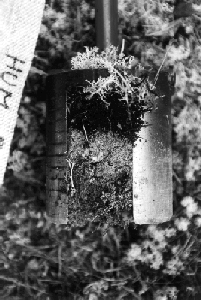![[cd2-22b]](/Kola/cd2-22b_.gif)
(Photo: C. Reimann)
Fig. 1: The uppermost, black soil horizon is the humus layer.

(Photo: C. Reimann)
Fig. 2: Black humus layer is at the top of the core, above the light gray E-horizon.
Rationale
Humus is the uppermost horizon of a soil, where plant material,
which is decomposed to various degrees, accumulates. It is equivalent
to the O-horizon of podzol profiles. Humus has a significant
binding affinity to trace elements and can accumulate them in
great amounts. This property as well as the position of the humus
layer in contact with the atmosphere, make humus a very useful
medium for geochemical mapping in the environmental context (airborne
pollution).
Advantages
Simple and cheap to sample (Figs. 1-2).
Adsorption properties and location make humus an ideal sampling
medium for environmental biogeochemistry.
Drawbacks
High spatial variability requires collection of many subsamples
at any one location.
Very thin humus layer in high alpine, arctic or coastal areas.